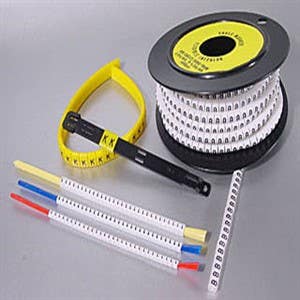Making a full wiring loom from scratch
Discussion
Max_Torque said:
Not if you buy a suitable identification system. ie

The fact you can then label every wire, and cross ref /document it makes fault finding easier imo!
A "loom board" type approach also makes things much, much neater!

use some cheap wire taped together to work out the lengths, routed and junctions, then fix it to a large MDF board. (you can screw cable tie saddles to each node point, with a large cable tie though each one, meaning wires can be slipped into the assy easily, cut to length, labelled, wrapped and then have their end plugs fitted etc
I'm sure that's the case when you know what you're doing, but for a first time you're going to get bits wrong, find you want to add some thing or relocate it, etc. All I can say is, where I skimped and didn't colour code, it made things harder.
The fact you can then label every wire, and cross ref /document it makes fault finding easier imo!
A "loom board" type approach also makes things much, much neater!

use some cheap wire taped together to work out the lengths, routed and junctions, then fix it to a large MDF board. (you can screw cable tie saddles to each node point, with a large cable tie though each one, meaning wires can be slipped into the assy easily, cut to length, labelled, wrapped and then have their end plugs fitted etc
Also, don't wrap it all up until it's in place and tested.
I'm rewiring a 1930's car at the moment,and in the search for 'heritage' cables found these guys. They may well do a complete loom for our car. Easier than making it.
https://www.autosparks.co.uk/
Cheers
https://www.autosparks.co.uk/
Cheers
Max_Torque said:
Another important tip: NO SOLDERING
crimping only if you want a long term reliable loom !
(you can make a reliable soldered loom, but it's very very hard to do, and requires very good mechanical support, vibration damping and wire harness tieing/routing etc)
I wouldn't entirely agree, but I understand the reason for your statement.crimping only if you want a long term reliable loom !
(you can make a reliable soldered loom, but it's very very hard to do, and requires very good mechanical support, vibration damping and wire harness tieing/routing etc)
I'd say there are benefits/disbenefits with both alternatives:-
If Soldering
a) If there is solder on the wire near the connector that part cannot 'flex' so is likely to break - this can be minimised by soldering with the connector at the lowest point so gravity doesn't pull solder along the wire, also using minimal solder
b) a resin flux shouldn't attack the wire, but removal of flux is best wherever possible
The alternative is to crimp, but that can also give problems
c) If the crimp isn't good the connector may fall off
d) Because there is (inevitably) a path for moisture between the wire strands and/or the connector, corrosion can happen
Gassing Station | Engines & Drivetrain | Top of Page | What's New | My Stuff


